Amidst the pandemic, Mandaluyong manages to reach a 10.2 percent increase in 2020
The population in the City of Mandaluyong continues to rise each year. From 386,276 in 2015, the total population of Mandaleños increased by 10.2 percent (39,482 persons), reaching 425,758 over five (5) years. (See Table 1)


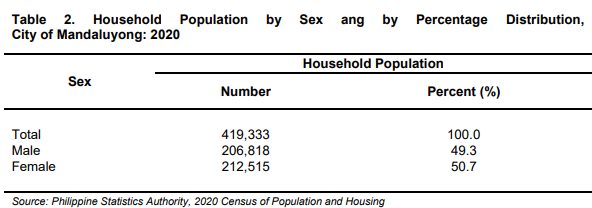
Among the top three (3) countries of citizenship identified in Mandaluyong, Philippines has a higher percentage of women than men
Country of citizenship refers to the place where a person is born or naturalized. Like many other countries worldwide, the Philippines is a home to various foreign nationals.
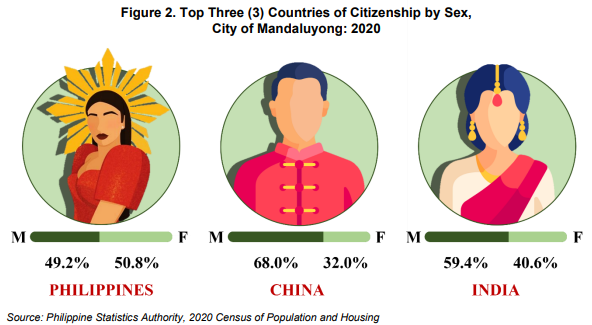
The top three (3) countries of origin for nationals residing in the City of Mandaluyong are the Philippines (417,056), China (654), and India (466), respectively. The Philippine citizens in Mandaluyong includes more women (211,687) than men (205,369). On the other hand, both China (68.0% or 445) and India (59.4% or 277) have a higher number of men than women. (See Figure 2 or Table 5)
Among the 27 barangays of Mandaluyong, Addition Hills (105,403), Highway Hills (43,194), and Hulo (31,314) recorded the highest household population in 2020. (See Table 5)

In Addition Hills, the highest number of residents are from the Philippines (105,317); China (17) and America (17); and Canada (13). Among the Filipino citizens, men make up 50.5 percent of its household population in Addition Hills. Meanwhile, Chinese citizens include 12 females, accounting for 70.6 percent of their total. In contrary, American citizens has a total of 9 males. On the other hand, Canadian citizens have a higher number of men (8) than women (5). (See Figure 3 or Table 5)
In Highway Hills, most residents are from the Philippines (42,567), China (265), and America (57). Among them, 51.9 percent (22,105) of Filipino citizens are women. In contrast, male citizens from China (72.5% or 192) and America (57.9% or 33) outnumber females in the barangay’s household population. (See Figure 3 or Table 5)
However, in the Barangay of Hulo, the top three (3) countries of citizenship are the Philippines (30,913), China (192), and India (26). Among these, the Philippines (51.4% or 15,900) has a higher number of women, while China (69.3% or 133) and India (69.2% or 18) has a higher number of men. (See Figure 3 or Table 5)
Majority of individuals with foreign citizenship are male
Citizenship is defined as the legal nationality of a person. A citizen is a legal national of the country at the time of census, while an alien is a non-national of the country (Philippine Statistics Authority, 2020). Nearly 100.0 percent of Mandaluyong’s household population in 2020 are Filipino citizens (417,056), while the remaining consist of Filipinos with dual citizenship (384) and foreign citizens (1,893). (See Table 3)
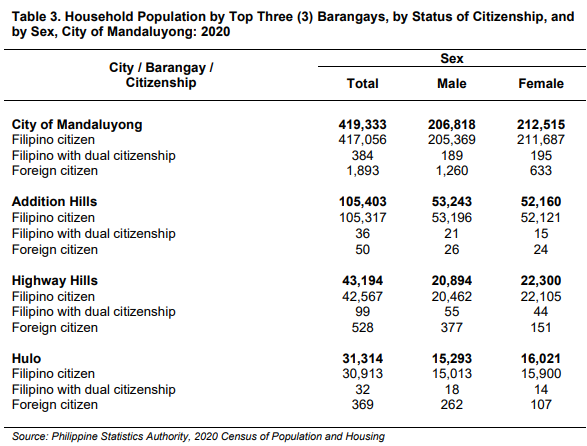
Household population of Filipino citizens includes more women than men by 1.5 percent or by 6,318 persons. Similarly, individuals with dual citizenship (50.8% or 195) have more women than men, too. In contrast, individuals with foreign citizenship (66.6% or 1,260) have a higher number of men than women. (See Table 3)
In these barangays, male citizens with dual and foreign citizenship make up a larger share of persons in their household population than females. However, Addition Hills has more Filipino male citizens (50.5% or 53,196) than female while Highway Hills (51.9% or 22,105) and Hulo (51.4% or 15,900) has more Filipino female citizens than male. (See Table 3)
More than half of Mandaluyong’s household population is divided among people of different ethnicities
Ethnicity is a primary sense of belonging to an ethnic group. Thus, ethnicity refers to the household member's identity, by blood and not by choice nor by adoption or confirmation for any ethnic group, primarily the Indigenous Peoples (IPs) (Philippine Statistics Authority, 2020).
In 2020, the top three (3) ethnicities in the City of Mandaluyong are Tagalog (48.3% or 202,595), Bisaya or Binisaya (14.9% or 62,480), and Bikol or Bicol (9.8% or 41,044), making up 73.0 percent of the city's household population. These three (3) ethnic groups have nearly equal percentages, with all recording a higher number of women than men. (See Table 4)
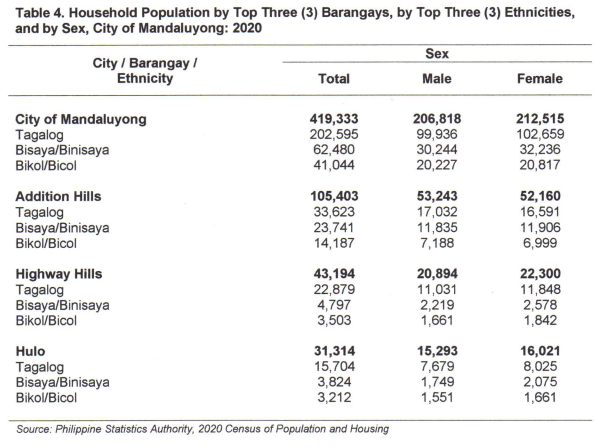
Additionally, in Mandaluyong's top three (3) barangays, Addition Hills (31.9%), Highway Hills (53.0%), and Hulo (50.2%), Tagalog is the predominant ethnicity, making up more than 30.0 percent of their household population. Bisaya or Binisaya follow, accounting for over 10.0 percent of the population, ranking second among the top ethnicities in these areas. Last but not the least, Bikol or Bicol ranks third in these barangays with 13.5, 8.1, and 10.3 percent, respectively. These ethnic groups have a higher number of women than men in the barangays of Highway Hills and Hulo. (See Table 4)
However, in Addition Hills, Tagalog and Bikol or Bicol have a greater number of males than females while Bisaya or Binisaya has more female than male. (See Table 4)
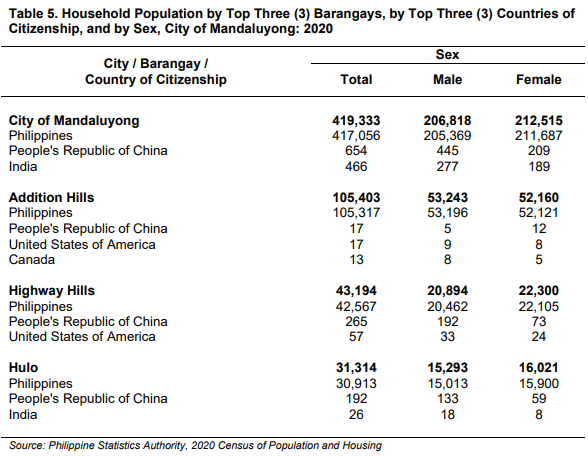
(SGD.) Amelia G. Basilio
Chief Statistical Specialist
Officer-in-Charge
